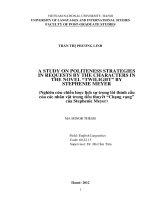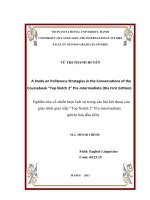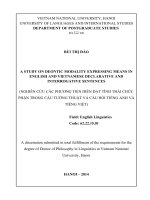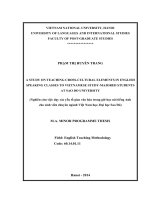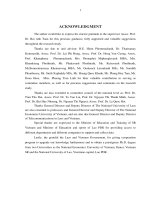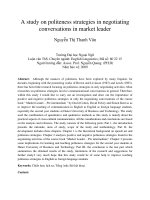a study on disagreeing strategies commonly employed in english with reference to those in vietnamese
Bạn đang xem bản rút gọn của tài liệu. Xem và tải ngay bản đầy đủ của tài liệu tại đây (1.46 MB, 99 trang )
MINISTRY OF EDUCATION AND TRAINING
HANOI OPEN UNVERSITY
M.A. THESIS
A STUDY ON DISAGREEING STRATEGIES
COMMONLY EMPLOYED IN ENGLISH WITH
REFERENCE TO THOSE IN VIETNAMESE.
(NGHIÊN CỨU NHỮNG CHIẾN LƯỢC BÀY TỎ SỰ BẤT ĐỒNG
THƯỜNG DÙNG TRONG TIẾNG ANH CÓ LIÊN HỆ VỚI TIẾNG VIỆT)
NGHIÊM THỊ THU HÀ
Hanoi, 2016
MINISTRY OF EDUCATION AND TRAINING
HANOI OPEN UNVERSITY
M.A. THESIS
A STUDY ON DISAGREEING STRATEGIES
COMMONLY EMPLOYED IN ENGLISH WITH
REFERENCE TO THOSE IN VIETNAMESE
(NGHIÊN CỨU NHỮNG CHIẾN LƯỢC BÀY TỎ SỰ BẤT ĐỒNG
THƯỜNG DÙNG TRONG TIẾNG ANH CÓ LIÊN HỆ VỚI TIẾNG VIỆT)
NGHIÊM THỊ THU HÀ
Field: English Language
Code: 60220201
Supervisor: Assoc. Prof. Dr. Vo Dai Quang
Hanoi, 2016
CERTIFICATE OF ORIGINALITY
I, the undersigned, hereby certify my authority of the study project report
entitled “A study on disagreeing strategies commonly employed in English
with reference to those in Vietnamese” submitted in partial fulfillment of the
requirements for the degree of Master in English Language. Except where the
reference is indicated, no other person’s work has been used without due
acknowledgement in the text of the thesis.
Hanoi, 2016
NGHIÊM THỊ THU HÀ
Approved by
SUPERVISOR
Date:……………………
i
ACKNOWLEDGEMENTS
This thesis could not have been completed without the help and support from
a number of people.
First and foremost, I would like to express my sincere gratitude to Assoc.Prof.
Dr. Vo Dai Quang, my supervisor, who has patiently and constantly supported
me through the stages of the study, and whose stimulating ideas, expertise,
and suggestions have inspired me greatly through my growth as an academic
researcher.
A special word of thanks goes to all my lecturers, colleagues, staff and
students at Hanoi University of Industry and many others, without whose
support and encouragement it would never have been possible for me to have
this thesis accomplished.
Last but not least, I am greatly indebted to my family, my husband for the
sacrifice they have devoted to the fulfillment of this academic work.
ii
ABSTRACT
Based on the theoretical framework of pragmatics, this study investigates
the ways in which the speech act of disagreeing is expressed by
Vietnamese people and native speakers of English. There were 80 people
participating in the study (40 Vietnamese teachers in HAUI and 40 native
English speakers), who were randomly selected from the researcher’s
colleagues, neighbors and acquaintances of different ages, genders and
social status. The participants were asked to complete a discourse
completion test (DCT) designed by the researcher, which was about three
situations, and react to them via making disagreements. Respondents
were expected to disagree with the three situations that they had to
express their disagreement.
The main findings of the study are prominent strategies for disagreeing
commonly employed by English speakers with reference to similarities
and differences in disagreeing strategies commonly employed
by
Vietnamese under investigation according to age, gender, and social
status. This study also suggests some implications for teaching the
politeness strategies in English to EFL learners in Vietnam.
iii
LIST OF ABBREVIATIONS
#
Number
&
And
D
Relative distance
D/I
Directness/ Indirectness
DCT
Discourse Completion Task
EFL
English as a foreign language
FTA
Face threatening act
H
Hearer
P
Relative power
R
Rating of imposition
S
Speaker
ST
Situation
HaUI
Hanoi University of Industry.
iv
LIST OF TABLES AND FIGURES
Table 2.1 The five general function of speech act
14
Table 2.2.The general patterns of preferred and dispreferred structure
33
Table 4.1. The common strategies for disagreeing in English and
42
Vietnamese.
Figure 1. Possible strategies for doing FTAs (Brown and Levinson,
23
1987:69)
Figure 2. Strategies for performing a disagreement. (Nguyen,2003:18)
27
v
TABLE OF CONTENTS
CERTIFICATE OF ORIGINALITY ............................................................... i
ACKNOWLEDGEMENTS............................................................................ ii
ABSTRACT .................................................................................................. iii
LIST OF ABBREVIATIONS ....................................................................... iv
LIST OF TABLES AND FIGURES............................................................... v
TABLE OF CONTENTS .............................................................................. vi
Chapter 1 ........................................................................................................ 1
INTRODUCTION.......................................................................................... 1
1.1 Rationale for the research ......................................................................... 1
1.2 Aims of the research ................................................................................. 3
1.3 Objectives of the research......................................................................... 3
1.4. Scope of the research ............................................................................... 4
1.5. Significance of the research ..................................................................... 4
1.6. Structural organization of the thesis......................................................... 5
Chapter 2 ........................................................................................................ 6
LITERATURE REVIEW ............................................................................... 6
2.1 Review of previous studies ....................................................................... 6
2.1.1 Previous studies overseas ...................................................................... 6
2.1.2 Previous studies in Vietnam .................................................................. 8
2.2 Review of theoretical background ............................................................ 9
2.2.1 Theoretical framework .......................................................................... 9
2.2.2 Theoretical background ...................................................................... 11
2.3. Disagreeing in Vietnamese and English................................................. 28
2.4. Chapter summary .................................................................................. 35
vi
Chapter 3 ...................................................................................................... 36
METHODOLOGY ....................................................................................... 36
3.1 Research-governing orientations ............................................................ 36
3.1.1 Research questions .............................................................................. 36
3.1.2 Research setting................................................................................... 36
3.1.3 Research approach ............................................................................... 37
3.1.4 Data collection and data analysis ......................................................... 38
3.2 Research methods ................................................................................... 38
3.2.1 Major methods vs. supporting methods ............................................... 38
3.2.2 Data collection instruments ................................................................. 39
3.2.3 Data analysis techniques ...................................................................... 40
3.3 Chapter summary ................................................................................... 41
Chapter 4 ...................................................................................................... 42
FINDINGS AND DISCUSSIONS ............................................................... 42
4.1. Strategies for disagreeing employed by English and Vietnamese people 42
4.1.1 Results of the survey ........................................................................... 42
4.1.2. Realizations of strategies for disagreeing in English and Vietnamese . 44
4.1.3. The strategy employment for expressing disagreement by English and
Vietnamese speakers .................................................................................... 54
4.2. Major cross-cultural similarities and differences in using the strategies to
express disagreement by English and Vietnamese speakers.......................... 58
4.2.1. Similarities ......................................................................................... 58
4.2.2. Differences: ........................................................................................ 59
4.3 . Implications of the research findings .................................................... 61
4.3.1 Implication on teaching English disagreeing strategies to EFL
Vietnamese learners ..................................................................................... 61
vii
4.3.2 Implications on learning English disagreeing strategies ....................... 62
4.4 . Chapter summary ................................................................................. 63
Chapter 5 ...................................................................................................... 64
CONCLUSION ............................................................................................ 64
5.1 Recapitulation ........................................................................................ 64
5.2 Concluding remarks ............................................................................... 64
5.3 Limitation of the current research ........................................................... 66
5.4 Recommendations for further research ................................................... 67
APPENDIX 1 ................................................................................................. 1
BẢNG CÂU HỎI KHẢO SÁT ...................................................................... 1
APPENDIX2 ................................................................................................. 4
SURVEY QUESTIONNAIRE ..................................................................... 4
IN ENGLSH................................................................................................... 7
In Vietnamese .............................................................................................. 13
viii
Chapter 1
INTRODUCTION
1.1 Rationale for the research
Language enables us to communicate ideas, thoughts, emotions, and
information. Communication can only succeed with both linguistic
competence and knowledge of social values, status, norms, and relations
among individuals, which is known as communicative competence.
Communicative competence is defined as “the ability not only to apply
grammatically correct sentences but also know when and where to use the
sentences and to whom” (Richards, Platt, & Platt 1992: 65). Put in another
way, communicative competence is the ability to use language correctly and
appropriately.
Lacking
communicative
impoliteness,
misinterpretation,
culture
competence
shock
would
and/or
result
in
communication
breakdown (Saville - Troike M 1986).
Since the Doi Moi (Economic Renovation) policy in 1986, English has been
considered by Vietnamese people as a key factor facilitating this economic
development policy. The Vietnamese see English as the key to opening doors
in science, technology, commerce, and to the better living standard that they
crave (Denham, 1992). The Vietnamese government has also emphasized the
role of English in the socio-economic development of the country. Therefore,
the demand for English proficiency in jobs, business, and communication has
been increasing all over the country. ELT is gaining higher status, with
English becoming a preferred foreign language for teaching in Vietnam.
English is a compulsory subject for national final examinations, and has
recently become compulsory in all levels of education.
As indicated above, there is an urgent need to improve Vietnamese students'
communicative competence besides their grammatical and lexical knowledge.
1
Verbal communicative competence has recently been gaining increasing
emphasis in English teaching in Vietnam for the purpose of effective
communication. Among the four English language skills (i.e. listening,
speaking, reading and writing), speaking is considered the most important in
this period of globalization of Vietnam. Learners of English should be aware
of socio-cultural factors for effective communication in the target language
(Downes 1984), and Vietnamese learners of English are not an exception.
Disagreeing is chosen for investigation in this study not accidentally. First, in
the notional-functional framework (Van Ek, 1976) disagreeing is among those
functions which ‘express intellectual attitudes’ (Hatch, 1992). In general,
communicative functions are not only lan guage-specific; they are culturespecific as well. The difference in the ways in which languages realize the
same function seems to make it problematic for language learners to say the
right thing at the right time. Second, a number of studies concerning different
speech acts, such as thanking, advising, requesting, apologizing etc., has been
carried out in this college. However, none of the research has focused on
disagreeing. Thus a comparison of the ways used to realize the speech act of
disagreeing by English native speakers of English and native speakers of
Vietnamese is considered to be valuable to the teaching and learning of
spoken English here in Vietnam.
This study is motivated by the speech act theory initiated by Austin (1962) and
refined by Searle, J.R. (1969, 1975), the politeness theory posited by Brown and
Levinson (1978, 1987), Leech,G. (1983) and works on the same issues in nonwestern languages by Wierzbicka, A. (1985) and Gu, Y. (1990), etc.
Within the same socio-cultural background, there seems to be few problems
in oral communication; yet people of different cultures may find trouble
knowing how, when to say what to whom in a second or foreign language.
Among many socio-cultural aspects, disagreeing is of great interest to the
2
researcher of this study for the following reasons: first, ways of expressing
disagreement are considered by previous researchers to have caused
difficulties for language learners in oral communication; second, there have
been studies on such issues as advising, requesting, apologizing, and thanking
in the target language with reference to Vietnamese as the first language, yet
disagreeing is of only few Vietnamese researchers’ concern in their own
contexts. For these two reasons, this study would aim to look at the speech act
of disagreeing by English speakers with reference to their Vietnamese
equivalents. The findings of this study would contribute to better
understanding and knowledge of the English language from the socio-cultural
aspect, which would help Vietnamese students of English learn to
communicate spoken English more effectively.
It is hoped that within these theoretical approaches and notions, a description
of the speech act of disagreeing and the strategies explored in its realization
will be made. The effects of socio-cultural parameters on the choice of
appropriate strategies will be investigated empirically to reveal the similarities
and differences between the two languages under study.
1.2 Aims of the research
The study is carried out for the following aims:
i. To help Vietnamese learners of English know what politeness
strategies are commonly employed in expressing disagreement in
English and Vietnamese.
ii. To help teachers apply successfully the results of the research in
teaching EFL learners the disagreeing strategies in English.
1.3 Objectives of the research
To gain the aims mentioned above, two objectives can be proposed as
follows:
3
i.
Pointing out the major similarities and differences between English and
Vietnamese in the employment of politeness strategies for expressing
disagreement.
ii.
Providing some possible implications for teaching the English
disagreeing strategies to EFL Vietnamese learners.
1.4. Scope of the research
i. Academic scope:
This study was conducted within the verbal aspect of the speech act. Degrees
of directness, indirectness, and politeness in expressing disagreement with
power-unequal English and Vietnamese are presented.
ii.
Social scope:
The current study was conducted in Hanoi, Vietnam, where the researcher is
living and working. The sources are taken from books, journals, newspapers
(either online or printed versions), and real-life conversations, which are
relevant to the issue under investigation.
1.5. Significance of the research
Theoretically, the systematically organized information in the study may help
learners gain an insight into disagreement strategies of English and
Vietnamese native speakers; it is hoped that the study would find out the
similarities and differences of disagreement strategies by English and
Vietnamese people; and exploring factors affecting the way disagreement
strategies are used by both English and Vietnamese speakers.
Practically, it is expected that the study will contribute to the literature of the
area of interest (disagreement strategies), and help to improve communication
between speakers of English and Vietnamese people in light of cross-cultural
aspects.
4
1.6. Structural organization of the thesis
This study consists of five chapters as follows:
Chapter 1 is the introduction to the study, which examines the rationale, aims,
objectives, scopes, significance, and structural organization of the study.
Chapter 2, Literature Review, has two main sections, namely review of
previous studies on the area under investigation, and review of theoretical
background of the study.
Chapter 3, Methodology, provides the research-governing orientations and
research methods employed in the study.
Chapter 4 convers the findings, discussions, and implications of the study
findings.
Chapter 5, the summary of the findings, concluding remarks, limitations of
the study, and recommendations for further research are presented.
5
Chapter 2
LITERATURE REVIEW
2.1 Review of previous studies
2.1.1 Previous studies overseas
The works covering the issue under investigation of disagreeing strategies in
English, among which some referred to their first language for comparison
and contrast will be presented in this section of the study.
The study by Behnam & Niroomand (2011) investigates the ways power
relations influence politeness strategies in disagreement. In order to determine
whether and to what extent the realization of the speech act of disagreeing and
the of appropriate politeness strategies by Iranian EFL learners, in a
university setting, across different proficiency levels (intermediate and upperintermediate) differ in relation to people with different power status a
Discourse Completion Test (DCT) was completed by 40 Iranian EFL learners
who were placed at two different levels based on their scores on a proficiency
test. The DTC consists of five scenarios in which the subjects are expected to
disagree with two higher statuses, two with peers and one with a lower status.
The selection of disagreement situations in DCT were based on relative power
and status of people. The findings of this study provide some evidences for
the relation between the learners' level of language proficiency and type and
frequency of disagreement and choice of politeness strategies associated with
people with different power status. In conclusion, it was argued that the
results can be closely related to learning contexts and textbook contents.
Finally some suggestions such as making learners aware of second language
pragmatic rules and socio-cultural constraints on speech acts as well as
grammatical rules in order to have a successful communication were put
forward regarding the issue.
6
The work by Choyimah and Latief (2014) aims at finding out patterns of the
relationship between students’ strategies in disagreeing and their English
proficiency using qualitative conversational analysis. Students joining
Seminar on Linguistics course in the School of Culture Studies at University
Brawijaya (UB) Indonesia in the odd semester of 2010-2011 were the
participants of this research. They were classified into four levels of language
proficiency: pre-intermediate, intermediate, pre-advanced, and advanced
according to their TOEFL scores. The data of this study were students’
utterances containing the force of disagreement, their TOEFL scores, and
their responses to interviews. The findings of this research suggest that
students’ strategies in disagreeing can be classified into two macro strategies:
direct and indirect strategies. Direct strategy covers four micro strategies:
refusal, denial, correction, and strong criticism. Indirect strategy was
represented in four micro strategies: mild-criticism, internally-contrasting,
reminding, and suggestion. Besides, the findings revealed that students having
higher levels of English proficiency tended to use indirect strategies, but those
at lower levels used direct ways in disagreeing.
The research by Kreutel (2007) analyzes the devices used by learners of
English as a Second Language (ESL) in order to perform the speech act of
disagreement in their L2. Data from 27 ESL learners were gathered by means
of discourse completion tests and compared to baseline data from 27 native
speakers of English. It was found that non-native speakers use mitigational
devices such as hedges or explanations less frequently than native speakers,
but often resort to undesirable features such as the "blunt opposite" or
message abandonment. Moreover, three additional features of target-like
disagreement expression were identified, namely, suggestions, exclamations,
and a "sandwich pattern of mitigation." The data suggests that high lexicogrammatical proficiency does not necessarily imply high pragmatic
7
competence. The findings are discussed in light of Wolfson's Bulge Theory,
and teaching implications are discussed.
2.1.2 Previous studies in Vietnam
In the study by Kieu (2006), the speech act of disagreeing in English and
Vietnamese within the theoretical frameworks of pragmatics and conversation
analysis is presented. The study gave an insight into such issues as politeness,
its notions and relations with indirectness, strategies and linguistic devices
used to express disagreement tokens in the English and Vietnamese languages
and cultures. Linguistic politeness is carefully examined in its unity of
discernment and volition. The findings exhibit that the differences in choosing
politeness strategies to perform disagreements by speakers of English in
North America and speakers of Vietnamese in Hanoi result from the
differences in their assessment of socio-cultural parameters and social
situations. Although indirectness might be used in some contexts as a means
to express politeness, there is no absolute correlation between politeness and
indirectness in the two languages and cultures under investigation. The study
found that English and Vietnamese speakers adopt the same strategies in
regards to preference organization, compliment responses and negotiation of
disagreements. On the whole, disagreements are inclined to be hedged or
delayed by a variety of softeners and/or other devices. However, they tend to
be overtly stated in responses to self-denigrations. The English informants
show a trend towards compliment acceptance and appreciation, while the
Vietnamese prefer to refuse and negate prior complimentary tokens in spite of
their similar strategies in adopting mid-positions. The accounts for this
phenomenon can be found in the Vietnamese community-based solidarity and
the Anglophone individualistic satisfaction.
8
This first section of the literature will help the researcher to conduct her
empirical study on disagreement strategies in English and refer to Vietnamese
as the first language.
2.2 Review of theoretical background
Review of concepts and theoretical frameworks is employable as tools for the
current research.
2.2.1 Theoretical framework
According to Austin (1962), when saying something, people are actually
doing something. This view can be considered as a breakthrough in linguistics
as it points out that many sentences are not intended to make true or false
statements. Those utterances were called “performatives” by Austin (1962).
Other previous researchers (e.g. Brown & Yule 1983; Grice 1975; Hymes
1964; Searle 1969, 1975, 1979; Thomas 1995; Yule 1996) believed that when
conversing, humans use grammatical and lexical units not only for producing
utterances but also for performing actions. Speech acts are, thus, defined by
these linguists as actions that are produced via utterances for communication.
In other words, speech acts are considered as basic or minimal units of
linguistic communication that are performed in authentic situations of
language use (Searle 1969). Speech acts include compliment, apology,
request, disagreeing or promise, which are used to name communicative
intentions of speakers, which help to distinguish human noise from any other
natural noise.
Intentions of speech acts are speakers’ intentions and hearers’ interpretation
of the intentions. The circumstances surrounding utterances can help both the
speaker and the hearer to comprehend correct information. These
circumstances are called speech events, in which conversers interact via
languages conventionally for successful comprehension (Yule 1996). In other
9
words, speech acts and speech events are two important components of
successful communication.
As mentioned in Brown and Levinson theory (1987), some of the speech
acts are face threatening by nature because of neglecting the face wants of
interlocutors. They define the face threatening acts (FTAs) according to the
person whose face is being threatened and the type of paying no attention to
the face (negative/positive face) and also mention that when one speaker
does not consider the self-image of the addressee the positive face has been
neglected and whenever there is a pressure on the addressee to accept or
reject the future act of the speaker there has been a case of neglecting the
negative face.
In terms of opinion giving, the speech act of disagreement is considered as a
face-threatening verbal behavior in which people can show their
dissatisfaction or opposition; therefore, applying an appropriate strategy to
show disagreement to interlocutors with different social statues can decrease
the possible danger of threatening the face of the addressee. And in the
process of selecting strategies, power can play a crucial role. Brown and
Levinson (1987) for example assert that "power is an asymmetrical social
dimension of relative power" (p. 77). The relative power of the addressee,
the degree of imposition and the social distance that exists between the
speaker and the addressee are the main points that an individual considers to
estimate the degree of the seriousness of an FTA (Brown & Levinson, 1987).
10
2.2.2 Theoretical background
2.2.2.1. Theory of speech acts
* Definition of speech acts:
Speech acts is a term taken from the word of philosophers of
languages, John Searle and John Austin in particular who assumes that in
saying something, a speaker also does something. Making a statement may be
the paradigmatic use of language, but there are sort of other things we can do
with words. We can make requests, ask questions, give orders, make
promises, give thanks, offer, apology and so on. Speech act theory was first
formulated by the philosopher John Austin (1962) in his influential work,
“How to do things with words”, is one of the most compelling notions in the
study of language use.
Since its initiation, it has been inherited, refined, and developed by a
number of philosophers and linguists as Levinson (1983:226) claims, “Of all
the issues in the general theory of language usage, speech act theory has
probably aroused the widest interest”.
That wide interest in the speech act theory can clearly be seen from
Blum- Kulka’s review:
“Speech acts have been claimed by some (Austin,1962;Searl,1962,1975)
to operate by universal principles, and claimed by others to vary in
conceptualizations and verbalizations across cultures and languages
(Wierzbicka,1985). Their modes of performance carry heavy social
implications (Ervin-Tripp,1977) and seem to be ruled by universal principles
of cooperation and politeness (Brown and Levinson,1978;Leech,1983).And
yet, cultures have been shown to vary drastically in their interactional styles,
leading to different preference for modes of speech act behavior. Culturally
11
coloured interactional styles create culturally determined expectations and
integrative strategies; and can lead to breakdowns in intercultural and
interethnic communication (Grumperz,1978)”
(Blum- Kulka et al.,1989:1)
Austin (1962) classified speech acts as involving three acts, which are
locutionary, illocutionary, and perlocutionary. These three kinds of acts
constitute what human beings do with words. In the following example:
Speaker: I’ve just made some tea
The first dimension, locutionary, is a phonetic act, a linguistic act, a
referring act, an act of producing a meaningful linguistic expression. So with
the above example, the meaning of the words uttered by the speaker comes
exactly from the words themselves (meaning the speaker has just made some
tea). The second dimension, illocutionary, is the act of performing an
utterance with a purpose, or, in other words, the speech contains a force. The
speech can be understood as an offer of some tea by the speaker for the
hearer. In the third dimension, perlocutionary, the speaker intends to have an
effect when producing an utterance with a function. So for the above
example, the hearer may get some tea as the result of the speaker’s speech.
These ultimate effects are dependent on the context of the utterance and
therefore can be unpredictable. The hearer may understand the speaker’s
intention correctly and does what his/her interlocutor wants, or he/she may
deliberately ignore the speaker’s want or desire.
Based on Austin’s work, Searle (1969; 1975) put forward the notion of
direct and indirect speech acts. Direct speech acts refer to a transparent
relationship between form and function. Indirect speech acts display no such
12
relationship, and thus, their illocutionary force does not derive from the
surface structure. In other words, indirect speech acts consist of two acts, a
primary illocutionary act and a secondary act where the primary act operates
through and in force of the secondary one. Indirect speech acts are considered
universal across languages and make up the majority of everyday
conversations.
In a nutshell, an action created via an utterance is made of three acts :
locution, illocution, and perlocution.
* Classification of speech acts
Originally, Austin (1962) classified illocutionary acts into five basic
categories which are verdictive, expositive, exercitive, behabitive and
commissive. However, not satisfied with this classification, Searle (1976: 1016) developed an alternative taxonomy of the fundamental classes of
illocutionary acts. The taxonomy consists of five categories or five types of
general functions performed by speech acts:
1. Declarations: Speech acts that bring some change to the reality of the
world in accord with the proposition of the declaration. E.g. declaring,
christening, baptisms, pronouncing someone guilty or pronouncing
someone husband and wife.
2. Representatives: The speech acts commit the speaker to the truth of
the expressed proposition (e.g., reciting a creed, asserting, disagreeing).
3. Expressives: The speech acts that express the speaker's attitudes and
emotions towards the proposition, e.g. congratulations, excuses and
thanks.
4. Directives: The speech acts that are to cause the hearer to take a
particular action, e.g. requests, commands and advice.
13
5. Commisives: The speech acts that commit a speaker to some future
action, e.g. promises and oaths.
G.Yule ( 1996: 55) summarizes the five general functions of speech acts with
their key features in the following table:
Speech act type
Direction of fit
S= speaker
X= situation
Declarations
Words change the world
S causes X
Representatives
Make words fit the world
S believes X
Expressive
Make words fit the world
S feels X
Directives
Make the world fit words
S wants X
Commissives
Make the world fit words
S intends X
Table 2.1. The five general functions of speech acts
(Yule, 1996: 55)
Apart from classifying speech acts according to their functions, linguists have
also divided them into direct speech act and indirect speech act. SavilleTroike (1982:36), for example, argues that:
“As defined in speech act theory, direct acts are those where surface
form matches interactional function, as ‘Be quiet!’ used as a command, versus
an indirect ‘It’s getting noisy here’ or ‘I can hear myself think’ ”.
This argument is clarified by Yule (1997: 54-55) when he suggests
basing on the relationship between the three structural forms (declarative,
interrogative, and imperative) and the three general communicative functions
14
(statement, question, and command/request) to decide which speech act is
direct and which one is indirect.
The author (1997: 54-55) claims, “Whenever there is a direct
relationship between a structure and a function, we have a direct speech act.
Whenever there is an indirect relationship between a structure and a function,
we have an indirect speech act”.
For example, the declarative structure, “It’s cold in this room” can
function as a direct speech act if it is used to make a statement (i.e. I hereby
tell you about the weather.) but it can also function as an indirect speech act if
it is intended as a command/request (i.e. I hereby request you that you close
the door).
2.2.2.2. Disagreeing as a speech act
According to Wierzbicka (1987), disagreeing is a dual act, an act of
saying 'what one thinks' and indicating 'that one doesn't think the same as the
earlier speaker'. Disagreeing is the act of showing that the second speaker
does has a different view or opinion. Let us look at the example by Pomerantz
(1978) given below:
(1).
a. The! No, it’s not really important.
b. Well I think it’s very important.
Pomerantz (1978) Compliment responses
It is observable that the act of disagreeing, like any other speech acts,
possesses both illocutionary force and propositional content. These two
properties of speech acts are realized syntactically, and the correct
understanding of the intended illocutionary force is inevitably dependent upon
the context. In terms of syntax, there is no necessary correlation between
structural forms and illocutionary forces.
15



